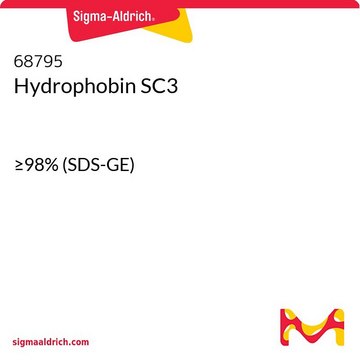PE0220
Plant Hydrophobic Protein Extraction Kit
Suitable for any plant species or tissue
Iniciar sesiónpara Ver la Fijación de precios por contrato y de la organización
About This Item
UNSPSC Code:
41105500
NACRES:
NA.56
Productos recomendados
Quality Level
storage temp.
−20°C
General description
The Plant Hydrophobic Protein Extraction Kit is designed specifically for use in plant bioscience to extract a qualitative sample of hydrophobic proteins from any type of plant species or tissue. The protocol does not require any ultracentrifugation or aqueous polymer two-phase partitioning (APTP). The kit includes three reagents, a plant specific protease inhibitor cocktail, a specially formulated reagent to extract hydrophilic proteins (Plant Protein Extraction Reagent Type 1), and a new chaotropic reagent with increased solubilizing power to extract more hydrophobic proteins (C0356, Protein Extraction Reagent Type 4). The protease inhibitor cocktail is a mixture of protease inhibitors with broad specificity for the inhibition of serine, cysteine, aspartic, metalloproteases, and aminopeptidases. It contains pepstatin A, E-64, leupeptin, 4-(2-aminoethyl)benzenesulfonyl fluoride (AEBSF), bestatin, and 1,10-phenanthroline. The cocktail has been demonstrated to be highly effective in preventing protein degradation during the extraction process.
Following removal of polyphenolics, tannins, and other interfering substances, ground plant tissue, fresh or frozen, is resuspended in a specially formulated reagent to extract hydrophilic proteins. After sequential extractions of the hydrophilic proteins, the chaotropic reagent is used to extract hydrophobic membrane bound proteins. Plant debris is pelleted by centrifugation and the hydrophobic protein extract is collected. The end result is a qualitative hydrophobic protein sample, ready for downstream proteomic analysis.
Following removal of polyphenolics, tannins, and other interfering substances, ground plant tissue, fresh or frozen, is resuspended in a specially formulated reagent to extract hydrophilic proteins. After sequential extractions of the hydrophilic proteins, the chaotropic reagent is used to extract hydrophobic membrane bound proteins. Plant debris is pelleted by centrifugation and the hydrophobic protein extract is collected. The end result is a qualitative hydrophobic protein sample, ready for downstream proteomic analysis.
Quantity
Sufficient for preparation of 20 separate extractions from plant tissue samples of 10-250mg
signalword
Warning
hcodes
Hazard Classifications
Acute Tox. 4 Oral - Aquatic Chronic 2 - Carc. 2 - Repr. 2
Storage Class
10 - Combustible liquids
flash_point_f
185.0 °F
flash_point_c
85 °C
Certificados de análisis (COA)
Busque Certificados de análisis (COA) introduciendo el número de lote del producto. Los números de lote se encuentran en la etiqueta del producto después de las palabras «Lot» o «Batch»
¿Ya tiene este producto?
Encuentre la documentación para los productos que ha comprado recientemente en la Biblioteca de documentos.
Siew-Yong Koay et al.
Journal of chromatography. B, Analytical technologies in the biomedical and life sciences, 879(22), 2179-2183 (2011-06-22)
Orthosiphon aristatus is a traditionally used medicinal plant. In order to study the proteome of the plant, we have developed a simple plant protein extraction method by direct extraction of protein using a modified 2D-gel compatible tris-sucrose buffer followed by
Angus L Dawe et al.
Methods in molecular biology (Clifton, N.J.), 722, 225-236 (2011-05-19)
The interaction of the filamentous fungal plant pathogen Cryphonectria parasitica with its virulence-attenuating viruses provides a unique platform to explore the molecular biology and genetics of virus-host interactions. Following the development of transformation procedures for this fungus, subsequent advances include
M Cilia et al.
Journal of biomolecular techniques : JBT, 20(4), 201-215 (2009-09-02)
Protein extraction methods can vary widely in reproducibility and in representation of the total proteome, yet there are limited data comparing protein isolation methods. The methodical comparison of protein isolation methods is the first critical step for proteomic studies. To
Ramesh Sundar Amalraj et al.
Electrophoresis, 31(12), 1959-1974 (2010-06-22)
Sugarcane is an important commercial crop cultivated for its stalks and sugar is a prized commodity essential in human nutrition. Proteomics of sugarcane is in its infancy, especially when dealing with the stalk tissues, where there is no study to
Yassel Ramos et al.
Analytical biochemistry, 377(2), 134-140 (2008-04-04)
We investigate the selectivity achieved after differential solubilization of bacterial proteomes following two procedures, both based on successive extraction of proteins in solutions of increasing solubilizing power. Recently, these procedures have gained notable popularity and several commercial kits are now
Nuestro equipo de científicos tiene experiencia en todas las áreas de investigación: Ciencias de la vida, Ciencia de los materiales, Síntesis química, Cromatografía, Analítica y muchas otras.
Póngase en contacto con el Servicio técnico







